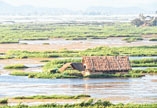Loktak’s challenges for survival
05 Nov 2024 00:02:58

Dr Eliza Khwairakpam
Loktak Lake is the only wetland in Manipur under the Ramsar Convention. Ramsar Convention is an inter-governmental treaty which provides the framework for National action plan and international cooperation for the conservation and wise use of wetlands and their resources. Ramsar Sites are designated because they meet the criteria for identifying Wetlands of International Importance. The lake has also been recognized under Montreaux record, indicating that changes in ecological character have occurred, are occurring, or likely to occur. It is a voluntary mechanism to highlight specific wetlands of interna- tional importance that are facing immediate challenges.
Loktak lake covers an area of 287 km2 and is oval in shape. The depth of the lake varies from 0.5 m during lean season to 4.6 m during rainy season, with an average depth of about 2.7 m. The characteristic feature of this lake is the extensive occurrence of vegetative floating masses, locally known as Phumdis. The survival of these Phumdis depends on the typical ecological phenomenon of sinking during lean season, gathering nutrients from the lake bed and staying afloat during rainy season. A contiguous 40 km2 area of Phumdis, named as Keibul Lamjao National Park (KLNP) by Government of India (GoI) is the only floating wildlife sanctuary in the world. This National park is the only natural home of the endemic and endangered species of Manipur’s brow-antlered deer, popularly known as Sangai, also the State animal of Manipur.
Importance of Loktak
Loktak Lake is considered to be the lifeline of Manipur due to its importance in the socio-economic and cultural life of the people. The lake sustains rich biological diversity with 428 species of animals and 132 plants species. This lake supports hydro-power generation, provide fisheries as the livelihood to about 8,700 fishermen, provides water for irrigation to about 32,400 ha agricultural area. The number of recorded Phum huts built by fishermen on Phumdis for shelter is 733. The annual benefits from Loktak Lake are estimated to about Rs 600 million, amounting to nearly 2% of the State’s gross domestic product.
Emerging Concerns of the Lake
Over the last four decades, emerging concerns pertaining to the overall health status of the lake include decreasing water holding capacity, deteriorating condition of Phumdis and prolific growth of Attaphums. Moreover, deterioration of water quality, decrease in aquatic bio-diversity and productivity, inundation of agricul- tural land and peripheral human settlements, degradation of habitat for Sangai deer etc.
Researchers and experts have sounded an alarm over the state of the lake. “Loktak Lake, a Ramsar site, is facing challenges of survival”. This is a big threat for various fish species, birds, both migratory and local. Water quality is deteriorating which is a bad sign-as observed by researchers and experts who has been regularly visiting the lake for survey.
Importance of Ramsar tag
Ramsar Secretariat designating a wetland as wetland of global importance may not lead to any extra funding by the global body, but it is like an accreditation. A Ramsar tag makes it incumbent upon authority to strengthen the ‘protection regime’ there and create defences against encroachment on wetlands. Designa- ting a wetland as a Ramsar site also means that it gets more public attention.
Saving Loktak is Saving Manipur
The role of the Loktak Lake in the State ecosystem, the need to preserve it and the benefit it brings are facts that must be subconsciously embedded in the minds of every child.
· There is a need to improve the water quality of the lake and various rivers draining into the lake. Waste water treatment conforming to an international standard is needed for better water quality. This will also attract tourists. However, it also poses unique challenges such as managing sewage and other wastes that flow directly into the lake from the population that resides in these areas that feed directly onto the lake. Thereby, there is also a need to support the socio-economic conditions of villagers residing in and around the lake.
· Ithai barrage operating policy should be designed in such a way that they are in a position to promote the rapid hydro dynamic passage time to the extent it is possible.
· Further considering the lake’s ecological nature, it is important to maintain a free Attaphums environment. Maintaining Khordak and Ungamel channels must be taken up under the proper supervision of the experts concerned.
· Watershed management programme, afforestation in the catchment area, soil erosion control programme should be executed successfully.
It is evident that there is a fundamental need to protect the ecology of the lake from the challenges stated above. Moreover, any initiative to be undertaken regarding the lake should be studied properly prioritizing the changing ecology of the lake. And since the lake is deeply linked to the socio-cultural and economic heritage of Manipur; Loktak should be protected from any onslaught of commercialization or privatization for the generations to come.
The writer is Assistant Professor at the Dept of Environmental Science, Nagaland University